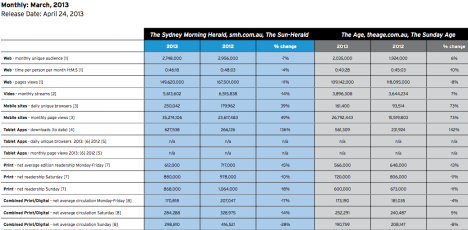Despite the move to compact, the trend is downwards for The Age and SMH
Press announcements issued on the afternoon before a public holiday rarely contain news the sender wants to go far and wide.
So I’m using that filter to view the arrival of the first numbers from Fairfax Media since it switched the Sydney Morning Herald and The Age to compact format.
 The picture is murky, but at first glance, the move – and more likely the marketing push accompanying it – has temporarily slowed the papers’ sales decline, but not arrested it.
The picture is murky, but at first glance, the move – and more likely the marketing push accompanying it – has temporarily slowed the papers’ sales decline, but not arrested it.
Sadly though, it looks like we’re going to have to wait until early August before we know for sure. But here’s how it looks to me.
The first point to make is that Fairfax has data that it has chosen not to release. About a year ago, it started publishing a monthly audience report for Sydney and Melbourne. This used to include details of average print circulation for its metro titles Monday to Friday, Saturday and Sunday. But it has now stopped doing so – instead, it has released a combined print/ digital circulation number.
Even with that smokescreen, the trend is undeniably still downwards – particularly in Sydney. As you’ll see below, that combined print and digital circulation number for March is down by 17 per cent Monday to Friday, compared to the same period a year before.
The fact that the still broadsheet Saturday SMH’s fall is slightly less – at 14 per cent – suggests that the change of format may not have made much difference at all.
I was expecting a bigger lift. When I covered the move of the UK broadsheets to compact nearly a decade ago, they experienced an annual sales uplift approaching 20 per cent, admittedly before resuming their downwards path.
Another reason to expect a bigger bump was the accompanying marketing push and media coverage of the relaunch. It wasn’t a great campaign, but at least it created noise in the market.
What makes this harder to read though is that we’re probably not quite at the one year anniversary since Fairfax switched strategy to stop giving away cheap subscriptions, meaning a year-on-year drop was always likely.
This is probably why the company’s press release chooses to focus on month-on-month changes rather than year on year.
It says that it saw paid circulation in Sydney and Melbourne across March rise by three per cent compared to February. This though is an average – my read is that Sydney was less than this and Melbourne a little more.
But any increase is an achievement. Few newspapers in the world can claim any positive territory whatsoever. It is, however, worth looking at those numbers a little more closely.
The statement from Fairfax also says that newsstand sales (which of course excludes home delivery subscribers) rose by 10 per cent in the first week and were up by five per cent over the whole month. Again these numbers are compared to the previous month and are, I’m sure, down year-on-year.
The number imply that the average increase for the next three weeks was only about three per cent, month-on-month. More likely the increase was something like 10 per cent in the first week, five per cent in the next , then three per cent, then two per cent – equating to that five per cent average across the month. And also suggesting that we’re already on the way back to a downwards trend.
In a couple of weeks, we get to see the audited numbers, when the Audit Bureau of Circulations results are published. However, these will cover an average of January, February and March’s sales, so the impact of the March 4 change will be somewhat blurred. Hence we’ll have to wait a further three months until early August.
There is also information to be gleaned from The Age’s numbers.
Most curious is the fact that the Saturday – broadsheet – edition grew its sales by 5 per cent while the new compact shrank by 4 per cent. I wonder if this could also be partly down to the Age brand getting a boost thanks to marketing of the compact move.
A further sales line to look at is Sundays. The compact Sydney product, the Sun-Herald, continues to freefall, down 28 per cent year-on-year. The broadsheet Sunday Age was down by eight per cent.
Despite the disappointing numbers, my own view is that the move to compact had to come. The new product is an improvement. The current management are simply suffering from the fact that their predecessors failed to make the jump eight or nine years ago. Now they’re doing what they can to catch up.
We remain on a timeline that means one day (hopefully in the medium rather than short term future) the papers won’t be print titles any more.
The move to compact format was one of the last levers to pull to delay that day.
It looks like it hasn’t worked.
Tim Burrowes



Herald-Sun is Melbourne and News Ltd.
Thanks, Lucy. Not the first time I’ve made that particular howler – you wouldn’t think I buy it every Sunday…
Cheers,
Tim – Mumbrella
What is a bank holiday?
Should be interesting to see the collapse in internet readership now that the paywall is up.
Hi Patrick,
That’s my British heritage showing through… amended to public holiday for clarity…
Cheers,
Tim – Mumbrella
thanks for the analysis Tim – a useful read. And you’re right, upward trends of any description in traditional media are not to be sneezed at.
I didn’t think the move to tabloid/”compact” was meant to halt the decline in circulation but to reduce production costs.
It’s pretty trendy to bash the media these days, the press in particular, but really, I would’ve thought that what’s in the paper would count more. Size isn’t everything, as the old saying goes.
I wish Fairfax all the best because, although the situation here is not as dire as the US or the UK, we need a diversity in Australia.
I read the SMH via ipad app every day and pay nothing. I encounter very few ads. I’m surprised that they haven’t started charging yet. Giving it away doesn’t seem like a business plan.
It is interesting to see that in NSW, even the combined print and digital circ numbers for Sunday are lower than the ABC numbers from Dec (14,667 lower). It will be interesting to see what this print number is without digital propping it up!
As I mentioned in a comment on the main article, Fairfax’s digital offerings are still the most popular in Australia, surpassing all other titles and products. I doubt this will change significantly with the paywall, as people will still be able to access a decent number of free articles. Also, News Limited will soon be introducing paywalls for the remainder of its titles. I’m a big fan of Fairfax journalism and personally really like the new compact format. I certainly hope they are around for a lot longer, as the reader above said – it’s so important for diversity. Imagine if the Tele was the only paper left on Sydney!
The Age goes tabloid but without tabloid writing.
No clear, concise, witty copy. Just same old same old.
Nothing will save Fairfax from going down the gurgler.
I was in the US in March when the paywall of SMH went up for foreign readers and ran up my ten free articles rather rapidly for the month. Wit a couple of weeks left to go, instead of paying, I merely pointed my browser at The Age and ran up another ten, then the other Fairfax city papers one after the other and got to read most of what I wanted without having to pay.
Now that I’m back home, I’m happy to head to my local Software Storage Vault each Tuesday morning and peruse a week’s worth of papers in the air conditioned comfort of an easy chair in the Coffs Harbour library. I get no pop up ads, no auto-start videos, don’t have to recycle them or shuffle them around the house. I get to read papers from around Australia and tons of magazines too, at no cost.
Best part is that all the money I save in home delivery, newsagent sales or subscriptions I am able to invest in a holiday to Hawaii each year for about 10 days. And to top it off, I’ve avoided the Choice magazine paywall when buying things by checking what month the article was published on that line of appliances or electronics and again, heading to the library to pull the issue and scan the article with my iPhone.
Great place to meet single women too I might add, generally sober and with guards down as opposed to meeting them in a bar or club.
Phil Tripp, what a tight ashed Scrooge you are. It’s thousands of people like you why Australianmedia is heading down hill.what an effort you go to in order to save a few dollars.
Well, I don’t think he is a Scrooge. If Fairfax too their digital strategy seriously, they’d have a way to combat the paywall flouting.
I paid for many years and made a transition from that old safe software of paper to online viewing without carrying around physical objects, fitting in reading where and when I want. I’m no scrooge, but I’m no fool either. It’s so much like the music business where the major corporates didn’t change with the times and offered the same old shit in gatekeeper mentality, protected or locked.
The Australian media industry is suffering more because it didn’t adapt and what they are offering readers are failing to adopt. It will probably shock the shit out of you that I am a freelance journalist published by News Ltd and many magazines. If I hadn’t started filing stories with email in 1983 and kept abreast of tech as a tool ever since for my content, I would have gone the way of those who believed typewriters were the be all and end all.
Another reason why they suffer declines is that no newsagent is going to actively promote this product. The low commision rates for newsagents makes the decision easy to promote other sectors of their business with higher mark-ups.
Also, Fairfax need to really push the fact that they have quality journalism as a lot of people are reader fatigued, esp with the government situation, and find themselves thinking that each day has the same old news…
Plus why doesnt Fairfax push the fact that actually reading a physical newspaper is a far different and more enriching experience than reading it online. Online is not the be all and end all and I think whichever Publisher wakes up to this fact first will find it very rewarding.
One of the main reasons that ‘The Age’ in Melbourne is declining is that it is an elitist leftist rag, more interested in pushing extremist ideologies than engaging in quality journalism. Their recent “rational suicide’ campaign is an example. ‘The Age’s’ editors actively promote a viewpoint that devalues humanity and puts in jeopardy the quality of health care for everyone – and they wonder why they are losing readership. I used to be a regular reader of ‘The Age’ until I grew tired of the propaganda, and this newspaper seems to be veering more and more into moonbat territory. It is fiddling while Rome burns.